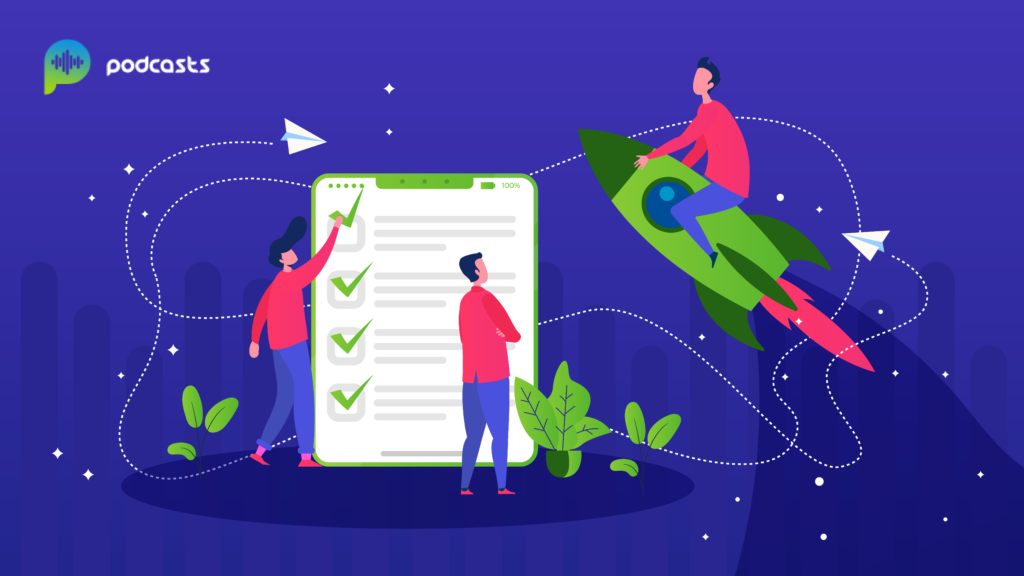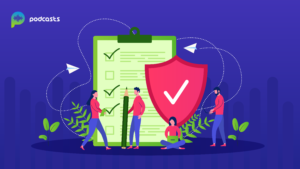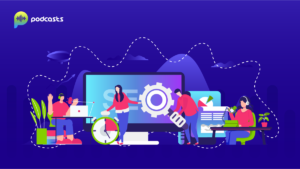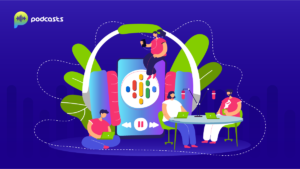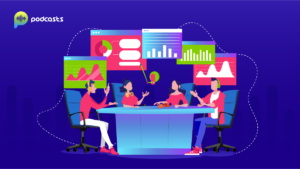If you’ve been thinking about launching a podcast for some time now, then now could be the perfect moment to get started. The popularity of podcasting is evolving at a rapid rate, with research from Edison showing that around 46 million Americans listen to at least 1 podcast per month. Just like a rocket launch needs a checklist, you’ll need a podcast launch checklist to help you get started.
Podcasting offers a unique opportunity in today’s marketplace. Unlike other forms of content, such as videos or articles, podcasts require very little effort or attention from your target audience. That might sound strange, but in today’s fast-moving world, it’s good to have a way of reaching your audience that doesn’t rely on their undivided focus. After all, we’re all constantly on the move, switching between locations and devices.
A podcast can stay with your audience wherever they go, whether they’re driving to work or checking emails on the tube. The question is, how do you start a podcast effectively? We’ve put together this quick podcast launch checklist, so you can make sure you have everything you need for a successful adventure into the podcasting world.
Step 1: Planning your Podcast
There’s more to planning a podcast than deciding how long you want your posts to be, or how many times you’re going to publish content a month. You’ll need to think carefully about the goals you want to achieve with your new marketing medium, and what kind of audience you’re going to reach.
- Decide what you want to accomplish with your podcast: Are you looking to expand your brand reach, or do you just want to give your customers another way to connect with your brand? Maybe you want to build a position as a thought leader.
- Choose your target audience: Who are you going to be trying to reach with this podcast? Deciding this in advance will help you to figure out what sort of podcast directories you need to be on, and what sort of topics you should cover.
- Select your theme: Decide what the core message or topic of your podcast is going to be. You might be talking about social media marketing, content analytics, or something else entirely. Remember to stick to topics your audience will care about
- Figure out how your podcast is going to make money: Are you going to be monetizing your podcasts with ads and sponsorships, or just hoping they’ll encourage people to buy more of your products?
- Choose your format and frequency: Decide how long your podcasts are going to be, and how often you’re going to release a new recording. You’ll also need to pick the format of your podcast, i.e interview, monologue, group dialogue, or a mixture?
- Invest in your podcasting equipment: You’ll need some basic equipment to get you started, such as a good-quality microphone, an audio editing software solution, and a podcast hosting service.
- Describe your podcast: Make sure you know how to describe the underlying essence of your podcast to other people who are interested in working with you to promote it.
Step 2: Building your Podcast Brand
Once you have a basic idea of the kind of podcast, you’re going to create in mind you’ll be ready to start developing an image for your new content strategy. This means figuring out how you’re going to capture your audience’s attention with your series through art and branding.
- Pick a name for your podcast: What do you want your series to be called? Make sure you speak your customer’s language and use keywords relevant to your content strategy If possible.
- Design your visual assets: You’ll need a cover image for your podcast, and you might want to include a logo in the mix too, so people can recognize that the content is coming from you.
- Create branded intros and outros: You might want to speak to a composer or a friend who can make a jingle for your podcast. Intro and outro music gives your podcasts a more professional and finished touch.
- Build your website: If you’re going to have a website for your podcast, make sure that it shows the right image of your brand. Stick to a website that’s easy to navigate for a better user experience.
- Choose a personality: Think about the kind of attitude you want to have in your podcast. Are you going to be fun and quirky, or serious and sophisticated? Your personality should align with your brand image.
Step 3: Producing your Podcasts
With your plans and your branding in place, you’re ready to start putting your idea into action, by recording your first episodes. There are a few things you’ll need to do to set yourself up for success at this stage, including:
- Choose your media format: Are you going to stick exclusively to audio, or do you want to include video and transcribed downloads from time to time too?
- Find the right software: You’ll need an audio editing software, as well as a recording tool that you can use to capture your content.
- Create your launch plan: Ensure that you know how to gain traction with your podcast with a well-thought-out launch plan. Cover how you’re going to get press attention for your podcast, which directories you’ll post on (i.e iTunes), and what promotion you’ll do.
- Find collaborators: If you’re going to create a podcast with guest interviews and other people, you’ll need to reach out to individuals that your audience will be interested in and collect as many details as possible.
- Find a booking system: A booking system like Calendly or Google Calendar will help you to keep track of the people you’re meeting with for interview podcasts.
- Create your first episode: Sit down and record your first episode. Listen to it and decide what you might want to change, and what you like about the format. You may need to start again from scratch a few times before you’re happy.
- Produce your first episode: Edit your audio, insert your outro and intro music, and tag your audio files. Once you’re ready, you can upload your podcast with your podcast hosting service and write a description for it.
Step 4: Distribution
Now that your podcast content has been fully recorded and produced, you can start to think about how you’re going to get your voice and brand out there through effective distribution. Distribution often takes a while to get right, so make sure you keep working on your go-to-market strategy.
- Set up podcast hosting: The audio files you create with your podcast are going to need a home. You won’t have the bandwidth to host your podcast yourself, so make sure you have a hosting service in place.
- Publish your content on your site and on directories: Place your podcast both on your dedicated website and send it to directories like Google Play and iTunes to make sure that more people hear it.
- Set up syndication for your podcast: You might need to set up a syndication strategy for your podcast, using WordPress plugins and additional software.
- Create a schedule: Remember to follow a consistent schedule with your podcast publishing, you’ll need your audience to know that they can rely on you to deliver something at a certain time each week.
- Set up an email list: Use a landing page on your website with free downloads or other lead magnets to convince your followers to sign up and be the first to hear about your new podcast episodes. This will help you to gauge interest in your content.
Step 5: Promote your Podcast
Remember, placing your podcasts on directories and your own website won’t automatically mean that people find your content and start linking to it. You need to make sure that you promote your podcasts, just like you would any other content. Don’t forget to:
- Link to your podcast in your emails: Let people subscribed to your email list know about your podcast and set up a separate email list specifically for people who want to learn about new episodes.
- Use social media: Post information about your latest podcast, including quotes from within the episodes on social media. This will expand your reach and get people excited about the material that you’re sharing.
- Link to your podcast in other content: When you’re publishing blogs and videos for your website, make sure to link out to podcast episodes when they offer some relevant information on the topic at hand.
- Pay to promote your podcasts: You can pay for paid promotion online through Google PPC ads to give your podcasts an extra boost or used paid ads on social media to reach a specific target audience.
- Work with influencers: Ask influencers to join you in promoting your podcasts. You might feature them on an episode and ask them to share it with their followers, or send them a freebie in exchange for a shout out.
- Get involved with guest opportunities: Appear on other people’s podcasts or write guest posts on the websites of other companies, so you have a chance to link back to your podcast URL and gain more followers.
- Set up referral campaigns: Reward your podcast followers with free discounts and other gifts when they refer new people to your website.
Step 6: Reviews and Measurement
The only way to make real progress with your podcast’s success is to gather as much information as possible from both your audience and the tools that you’re using. Make sure that you set up strategies to get as much data as possible, including:
- Feedback and reviews: Set up a star rating system or a comments section under your podcast on your website, so that your audience can give you feedback on what they liked and didn’t like about your recording.
- Use Google Analytics: Tools for web statistics like Google Analytics are excellent for gaining a useful insight into the potential of your podcasts. Some podcast hosting platforms also come with their own analytics tools.
- Listen on social media: Provide a branded hashtag with your posts then go on social media and find out what people are saying about your content. This is a great way to get a behind the scenes insight into what your customers want.
- Track your downloads: Keep track of how many people download or access your podcast on each of the directories that you’re using.
Step 7: After your Podcast
Once your podcast is recorded, edited, published, and promoted, there’s still work to do. Aside from checking your analytics and consistently measuring the performance of your campaign, you can also set yourself up for success in other ways. For instance:
- Plan future podcasts: Figure out what you’re going to do next and remember to be aware of any seasonal podcasts or special events that you want to cover.
- Leverage your new authority: As your podcast’s popularity grows, take advantage of it to get guest positions on other shows, or attract new thought leaders to take part in your conversations.
- Keep learning: Look for opportunities to improve your podcasts by enhancing your interviewing techniques or working on your knowledge of audio file editing.
- Use other modes of content too: Remember that podcasts are just one part of your content marketing strategy. Video, blogs, and other forms of content can be valuable to your business as well.
- Engage with your audience: Actively ask your audience for their opinion. Invite people to share what they would like to hear next on your podcast, or request insights from the people who listen to your content – you’ll create more relevant material this way.
Podcasting is an excellent way to give your brand more traction in today’s fast-paced and competitive environment. With the checklist above, you’ll have everything you need to launch your first podcast with the best possible chances of success.
Remember to have some fun with your podcast too. This is your chance to get your voice heard and show the world what you’re passionate about!
Good luck and get recording!

